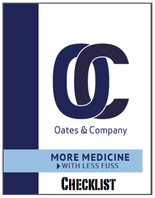A major obstacle for medical practices is record-keeping. Records of patient visits, payment methods, invoices, types of treatment given, and medications prescribed are all examples of what medical practices keep track of. What many people don’t consider, however, is that medical practices – just like every other business – also have to keep track of employee hours, inventory, overhead costs, and profitability.
Every medical practice has its own way of keeping records. For the most part, however, every practice keeps its patient and healthcare records separate from its business records. Some practices are still using hand-written patient charts, but even when patient records are electronic, they’re rarely integrated with the business records.
What this means is that office staff has to manually link medical records with the sources of payment, manually enter the business consequences of medical management into their accounting software, manually transfer patient information from medical charts to billing charts, etc. All of this manual labor increases the possibility of errors, decreases the accuracy of patient payment reports, requires extra staff, and wastes the time and energy of all involved.
 The smaller a practice is, the easier, of course, this manual labor is. But with ObamaCare being implemented over the next seven years, practices are only going to grow. And as a practice grows, the volume of transactions also grows. Exponential growth and manual labor are only going to increase mistakes, and increased mistakes means medical practices will start taking hits on both ends: with errors in patients records and in business records, which ultimately will affect revenue.
The smaller a practice is, the easier, of course, this manual labor is. But with ObamaCare being implemented over the next seven years, practices are only going to grow. And as a practice grows, the volume of transactions also grows. Exponential growth and manual labor are only going to increase mistakes, and increased mistakes means medical practices will start taking hits on both ends: with errors in patients records and in business records, which ultimately will affect revenue.
The solution is integrating the medical management software with the business software. For one thing, ObamaCare is requiring that all paper data be converted into electronic data – sooner rather than later. Once all medical information is electronic, combining systems can be as easy as choosing a software.
Centricity is a brand of software from GE Healthcare. It can work for independent physician practices, academic medical centers, hospitals, and large integrated delivery networks. Since its debut in 2003, it has expanded from two relatively generic applications to 27 very specific applications, such as a Cardiovascular Information System, an ICU system, and a Pharmacy system, among others. Each of the applications performs practice management, revenue cycle management, electronic medical records, medical imaging, and other functions.
NextGen Healthcare Information Systems is another piece of software that can combine business and healthcare systems. NextGen develops and sells electronic health record software and practice management systems. It is so effective that Forbes had it on its 200 Best Small Companies list for nine consecutive years. NextGen’s stated goal is to help patients, practitioners, and insurance companies connect on one platform. Like Centricity, NextGen has expanded its services and, also like Centricity, performs practice management, revenue cycle management, electronic medical records, and medical imaging.
The most important aspect of these systems is their ability to import and export information from the medical side and then to automatically populate the invoicing and accounting system. This saves significant amounts of time because manually spending time – even as little as a minute per invoice – can add up to hundreds of hours in even the smallest of practices; with these software systems, a single push of the button can move the information all at once and with far greater accuracy.
All of these possibilities serve to make medical practices smarter, more flexible, and – most importantly – more productive.
Let us find you better software and teach you how to use it -- contact Oates & Company LLC today.



